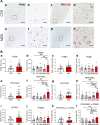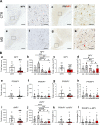Progesterone receptor distribution in the human hypothalamus and its association with suicide
- PMID: 38263257
- PMCID: PMC10807127
- DOI: 10.1186/s40478-024-01733-y
Progesterone receptor distribution in the human hypothalamus and its association with suicide
Abstract
The human hypothalamus modulates mental health by balancing interactions between hormonal fluctuations and stress responses. Stress-induced progesterone release activates progesterone receptors (PR) in the human brain and triggers alterations in neuropeptides/neurotransmitters. As recent epidemiological studies have associated peripheral progesterone levels with suicide risks in humans, we mapped PR distribution in the human hypothalamus in relation to age and sex and characterized its (co-) expression in specific cell types. The infundibular nucleus (INF) appeared to be the primary hypothalamic structure via which progesterone modulates stress-related neural circuitry. An elevation of the number of pro-opiomelanocortin+ (POMC, an endogenous opioid precursor) neurons in the INF, which was due to a high proportion of POMC+ neurons that co-expressed PR, was related to suicide in patients with mood disorders (MD). MD donors who died of legal euthanasia were for the first time enrolled in a postmortem study to investigate the molecular signatures related to fatal suicidal ideations. They had a higher proportion of PR co-expressing POMC+ neurons than MD patients who died naturally. This indicates that the onset of endogenous opioid activation in MD with suicide tendency may be progesterone-associated. Our findings may have implications for users of progesterone-enriched contraceptives who also have MD and suicidal tendencies.
© 2024. The Author(s).
Conflict of interest statement
The authors have no conflicts of interest to declare.
Figures




Similar articles
-
Surveillance for Violent Deaths - National Violent Death Reporting System, 50 States, the District of Columbia, and Puerto Rico, 2022.MMWR Surveill Summ. 2025 Jun 12;74(5):1-42. doi: 10.15585/mmwr.ss7405a1. MMWR Surveill Summ. 2025. PMID: 40493548 Free PMC article.
-
New generation antidepressants for depression in children and adolescents: a network meta-analysis.Cochrane Database Syst Rev. 2021 May 24;5(5):CD013674. doi: 10.1002/14651858.CD013674.pub2. Cochrane Database Syst Rev. 2021. PMID: 34029378 Free PMC article.
-
Sertindole for schizophrenia.Cochrane Database Syst Rev. 2005 Jul 20;2005(3):CD001715. doi: 10.1002/14651858.CD001715.pub2. Cochrane Database Syst Rev. 2005. PMID: 16034864 Free PMC article.
-
Treatments for seizures in catamenial (menstrual-related) epilepsy.Cochrane Database Syst Rev. 2021 Sep 16;9(9):CD013225. doi: 10.1002/14651858.CD013225.pub3. Cochrane Database Syst Rev. 2021. PMID: 34528245 Free PMC article.
-
Selective progesterone receptor modulators (SPRMs) for uterine fibroids.Cochrane Database Syst Rev. 2017 Apr 26;4(4):CD010770. doi: 10.1002/14651858.CD010770.pub2. Cochrane Database Syst Rev. 2017. PMID: 28444736 Free PMC article.
Cited by
-
Psychiatric safety associated with hormone replacement therapy for menopausal symptoms: a real-world study of the FDA adverse event reporting system.Front Psychiatry. 2025 Jun 27;16:1614087. doi: 10.3389/fpsyt.2025.1614087. eCollection 2025. Front Psychiatry. 2025. PMID: 40656051 Free PMC article.
-
Human post-mortem organotypic brain slice cultures: a tool to study pathomechanisms and test therapies.Acta Neuropathol Commun. 2024 May 31;12(1):83. doi: 10.1186/s40478-024-01784-1. Acta Neuropathol Commun. 2024. PMID: 38822428 Free PMC article.
References
-
- Batschelet E (1981) Circular statistics in biology. Academic Press, 111 Fifth Ave, New York, NY 10003, 1981, 388
-
- Behera C, Sikary AK, Mridha AR, Pandey RM, Satapathy S, Lalwani S, Gupta S (2019) Association of menstruation cycle with completed suicide: a hospital-based case-control study. Archives of women’s mental health: 1–7 - PubMed
-
- Benjamini Y, Hochberg Y. Controlling the false discovery rate: a practical and powerful approach to multiple testing. J Roy Stat Soc: Ser B (Methodol) 1995;57:289–300.
Publication types
MeSH terms
Substances
Grants and funding
LinkOut - more resources
Full Text Sources
Medical
Molecular Biology Databases
Research Materials
Miscellaneous

